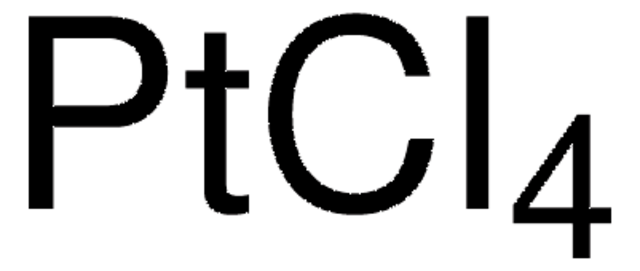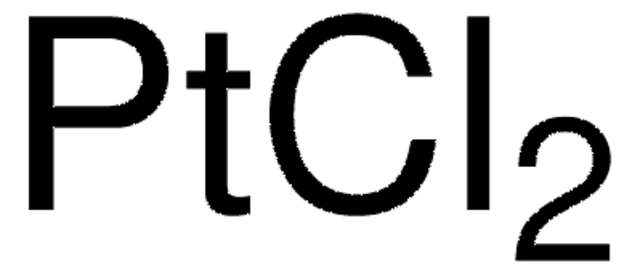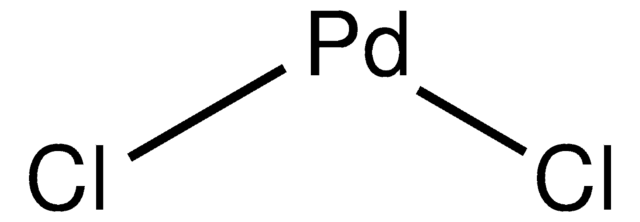379840
Platinum(IV) chloride
≥99.99% trace metals basis
Sinónimos:
Platinum tetrachloride
About This Item
Productos recomendados
grado
for analytical purposes
Nivel de calidad
Ensayo
≥99.99% trace metals basis
Formulario
powder and chunks
idoneidad de la reacción
reagent type: catalyst
core: platinum
impurezas
≤100.0 ppm Trace Metal Analysis
mp
370 °C (dec.) (lit.)
densidad
4.303 g/mL at 25 °C (lit.)
cadena SMILES
Cl[Pt](Cl)(Cl)Cl
InChI
1S/4ClH.Pt/h4*1H;/q;;;;+4/p-4
Clave InChI
FBEIPJNQGITEBL-UHFFFAOYSA-J
¿Está buscando productos similares? Visita Guía de comparación de productos
Categorías relacionadas
Descripción general
Aplicación
- As a precursor to synthesize Pt nanoparticles for photocatalytic hydrogen generation.
- As a starting material to prepare Pt/Al2O3 and Pt/ZrO2-SiO2 catalysts.
- To fabricate an electrocatalyst for proton exchange fuel cells.
- As a catalyst for the cyclization of arene−alkynesubstrates via intramolecular electrophilic hydroarylation.
Palabra de señalización
Danger
Frases de peligro
Clasificaciones de peligro
Acute Tox. 3 Oral - Eye Dam. 1 - Resp. Sens. 1 - Skin Corr. 1B - Skin Sens. 1
Código de clase de almacenamiento
6.1A - Combustible acute toxic Cat. 1 and 2 / very toxic hazardous materials
Clase de riesgo para el agua (WGK)
WGK 2
Punto de inflamabilidad (°F)
Not applicable
Punto de inflamabilidad (°C)
Not applicable
Equipo de protección personal
Eyeshields, Faceshields, Gloves, type P3 (EN 143) respirator cartridges
Elija entre una de las versiones más recientes:
¿Ya tiene este producto?
Encuentre la documentación para los productos que ha comprado recientemente en la Biblioteca de documentos.
Los clientes también vieron
Artículos
Plasmonic nanoparticles have unique optical properties that can be tailored to suit a variety of applications in the biotechnology1–8 and electronics9–16 industries.
Nuestro equipo de científicos tiene experiencia en todas las áreas de investigación: Ciencias de la vida, Ciencia de los materiales, Síntesis química, Cromatografía, Analítica y muchas otras.
Póngase en contacto con el Servicio técnico















